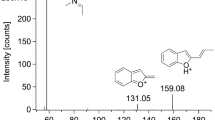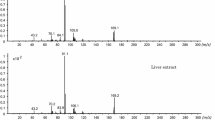Abstract
We encountered an autopsy case of a 35-year-old man who drowned in a bathtub. Nine opened packages of designer drugs containing herbal blends, powders, or liquid were found at the scene, implying abuse. The plasma and urine samples of the deceased were analyzed using liquid chromatography–time-of-flight-mass spectrometry (LC–TOF-MS) with MSE. A new synthetic cathinone, 4′-methoxy-α-pyrrolidinobutiophenone (4-MeOPBP), emerged as a suspected component via elemental composition and molecular structure analyses with acquisition of full spectra of the precursor and product ions by MSE mode. The component was finally identified by comparing the mass spectra obtained from the deceased’s samples with those of the reference standard 4-MeOPBP using LC–TOF-MS and gas chromatography–mass spectrometry. Furthermore, 4-MeOPBP was the main component of an opened package labeled “Silver Snow”. The concentrations of 4-MeOPBP in plasma and urine samples were as high as 9.5 and 12 μg/ml, respectively. To our knowledge, this is the first report disclosing 4-MeOPBP in human specimens.




Similar content being viewed by others
References
Yonamine M, Silva OA (2002) Confirmation of cocaine exposure by gas chromatography–mass spectrometry of urine extracts after methylation of benzoylecgonine. J Chromatogr B 773:83–87
Galloway FR, Bellet NF (1999) Methadone conversion to EDDP during GC–MS analysis of urine samples. J Anal Toxicol 23:615–619
Rosano TG, Wood M, Ihenetu K, Swift TA (2013) Drug screening in medical examiner casework by high-resolution mass spectrometry (UPLC–MSE-TOF). J Anal Toxicol 37:580–593
Guale F, Shahreza S, Walterscheid JP, Chen HH, Arndt C, Kelly AT, Mozayani A (2013) Validation of LC–TOF-MS screening for drugs, metabolites, and collateral compounds in forensic toxicology specimens. J Anal Toxicol 37:17–24
Plumb RS, Johnson KA, Rainville P, Smith BW, Wilson ID, Castro-Perez JM, Nicholson JK (2006) UPLC/MSE; a new approach for generating molecular fragment information for biomarker structure elucidation. Rapid Commun Mass Spectrom 20:1989–1994
Coppola M, Mondola R (2012) Synthetic cathinones: chemistry, pharmacology and toxicology of a new class of designer drugs of abuse marketed as “bath salts” or “plant food”. Toxicol Lett 211:144–149
Zaitsu K, Katagi M, Tsuchihashi H, Ishii A (2014) Recently abused synthetic cathinones, α-pyrrolidinophenone derivatives: a review of their pharmacology, acute toxicity, and metabolism. Forensic Toxicol 32:1–8
Borek HA, Holstege CP (2012) Hyperthermia and multiorgan failure after abuse of “bath salts” containing 3,4-methylenedioxypyrovalerone. Ann Emerg Med 60:103–105
Murray BL, Murphy CM, Beuhler MC (2012) Death following recreational use of designer drug “bath salts” containing 3,4-methylenedioxypyrovalerone (MDPV). J Med Toxicol 8:69–75
Namera A, Urabe S, Saito T, Torikoshi-Hatano A, Shiraishi H, Arima Y, Nagao M (2013) A fatal case of 3,4-methylenedioxypyrovalerone poisoning: coexistence of α-pyrrolidinobutiophenone and α-pyrrolidinovalerophenone in blood and/or hair. Forensic Toxicol 31:338–343
Sauer C, Hoffmann K, Schimmel U, Peters FT (2011) Acute poisoning involving the pyrrolidinophenone-type designer drug 4′-methyl-alpha-pyrrolidinohexanophenone (MPHP). Forensic Sci Int 208:e20–e25
Saito T, Namera A, Osawa M, Aoki H, Inokuchi S (2013) SPME-GC–MS analysis of α-pyrrolidinovaleorophenone in blood in a fatal poisoning case. Forensic Toxicol 31:328–332
Hasegawa K, Suzuki O, Wurita A, Minakata K, Yamagishi I, Nozawa H, Gonmori K, Watanabe K (2014) Postmortem distribution of α-pyrrolidinovalerophenone and its metabolite in body fluids and solid tissues in a fatal poisoning case measured by LC–MS–MS with the standard addition method. Forensic Toxicol 32:225–234
Namera A, Konuma K, Kawamura M, Saito T, Nakamoto A, Yahata M, Ohta S, Miyazaki S, Shiraishi H, Nagao M (2014) Time-course profile of urinary excretion of intravenously administered α-pyrrolidinovalerophenone and α-pyrrolidinobutiophenone in a human. Forensic Toxicol 32:68–74
Minakata K, Yamagishi I, Nozawa H, Hasegawa K, Wurita A, Gonmori K, Suzuki M, Watanabe K, Suzuki O (2014) MALDI-TOF mass spectrometric determination of four pyrrolidino cathinones in human blood. Forensic Toxicol 32:169–175
Hasegawa K, Wurita A, Minakata K, Gonmori K, Nozawa H, Yamagishi I, Suzuki O, Watanabe K (2014) Identification and quantitation of a new cathinone designer drug PV9 in an “aroma liquid” product, antemortem whole blood and urine specimens, and a postmortem whole blood specimen in a fatal poisoning case. Forensic Toxicol 32:243–250
Eiden C, Mathieu O, Cathala P, Debruyne D, Baccino E, Petit P, Peyriere H (2013) Toxicity and death following recreational use of 2-pyrrolidino valerophenone. Clin Toxicol 51:899–903
Acknowledgments
We thank Dr. Kanju Saka of the Department of Forensic Medicine, Graduate School of Medicine, at the University of Tokyo for advice on data analysis. This study was supported by JSPS KAKENHI Grant Number 25293162.
Conflict of interest
There are no financial or other relations that could lead to a conflict of interest.
Ethical approval
Informed consent was obtained from all healthy individuals included in the study, who supplied about 1 ml of whole blood and about 10 ml of urine for use as blank materials.
Author information
Authors and Affiliations
Corresponding author
Rights and permissions
About this article
Cite this article
Shintani-Ishida, K., Nakamura, M., Tojo, M. et al. Identification and quantification of 4′-methoxy-α-pyrrolidinobutiophenone (4-MeOPBP) in human plasma and urine using LC–TOF-MS in an autopsy case. Forensic Toxicol 33, 348–354 (2015). https://doi.org/10.1007/s11419-015-0281-x
Received:
Accepted:
Published:
Issue Date:
DOI: https://doi.org/10.1007/s11419-015-0281-x




